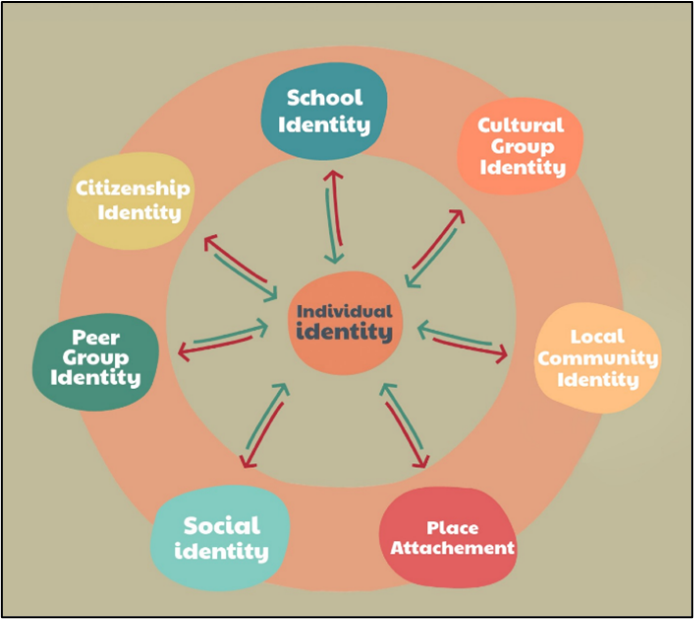Framework/Model

Connected Belonging is an evidence-informed approach to enhancing wellbeing in schools which acknowledges the importance of:
- different aspects of identity to children’s wellbeing
- supporting children’s connectedness and belonging to their various communities in enhancing wellbeing
- building on the reciprocal relationships children hold in the different social domains of their lives
We all have individual and social parts of our identity. The individual part wants to feel valued as a unique ‘special’ person, while the social part wants to feel a sense of togetherness and similarity within the different social groups of our lives (e.g. our family, school, community). Young people have argued that the most important thing for their school wellbeing is to feel they can authentically ‘be themselves’ and be valued as such. However, in order to feel this, they need to feel that the multiple social parts that make them are also recognised and valued in school.
Young people’s social relationships, -or connectedness, - within these different social domains can provide identity resources like trust and validation in generating a meaningful sense of belonging. They can also be a source of insecurity or anxiety that the young person needs help with.
Exploring and strengthening children’s connections within these different domains in their lives can enhance resilience and support their wellbeing. School’s role in wellbeing promotion therefore involves exploring and strengthening children’s sense of connection with seven key domains of their lives and how they support and enable what makes them unique as an individual.
Select a heading to show more detail about each domain of Connected Belonging.
Supporting School identity involves helping all to develop a positive learner identity and sense of belonging in school. Actively nurturing a sense of ‘belonging’ for all students, taking steps to foster everyone’s sense of feeling accepted, respected and fitting in plays a key role in young people’s wellbeing. Positive relationships with between staff, students and parents, and an inclusive climate where everyone looks out for each other are key.
Cultural group identity describes the part of a person’s identity or self-image that relates to their nationality, ethnicity, religion, faith or social class group. It is generally closely connected to family background, especially for younger pupils. As young people grow up they start to question, challenge or become more conscious of aspects of their cultural group identity. Cultural background can bring positive impacts and challenges for young people’s wellbeing. Growing up with more than one cultural influence can help you access different perspectives, and develop a strong sense of identity. It may also make you feel unsure about where you belong, or experience competing pressures or prejudice. Positioning the school as a hub of a diverse community, which welcomes and respects everybody and takes actions to represent and celebrate those groups who are frequently marginalised or disempowered is important.
Local community identity equates to children’s sense of being valued, connected members of their local communities. Supporting students’s connections with the local community might include enabling or celebrating their connections with local organisations, events, places, developments or issues. Access to this wider social network can offer young people other avenues to support their wellbeing outside of school and over time. Importantly, it can support children’s sense of belonging in the community, which gives them an important stake in society.
Place attachment recognises children’s emotional connection to spaces that can make them feel safe, calm, or ‘at home’ both inside and outside of the school. The sense that the spaces around the school site are welcoming and safe is central to all young people’s wellbeing, but is particularly critical for students who have experienced trauma, have high levels of anxiety, sensory impairments of physical disabilities.
Social identity relates to our intersectional identities, or how our identities arise from belonging to multiple, different social category groups. These include social groups related to individual identity for instance gender identity or sexuality; around abilities or impairments such as neurodivergence, being deaf or a wheelchair user; or around our life experiences such as being a young carer, care-experienced or seeking asylum in another country. Individuals can be multiply privileged or disadvantaged as a result of the collection of social groups that they belong to, so young people’s experiences through these unique identities can have a strong impact on the wellbeing challenges they face and the kinds of support that may help them.
Peer-group identity refers to children’s connectedness to friends and peers. Young people’s connections to friends and others around their age, both in person and online are particularly important as they grow older and become increasingly independent from their families. Support as they navigate relationships with their peer group can support the wellbeing challenges that can arise from experiences of loneliness, social anxiety, friendship difficulties, bullying and supporting friends and classmates.
Citizenship identity acknowledges children’s sense of being both national and global citizens of a diverse, multicultural society. Helping them to reflect on their place in the world, and in relation to national and global events can support wellbeing in diverse ways. It can help them explore feelings arising from crises like climate change, the pandemic or major conflicts. It can help them learn about positive action they might take. It can also support the development of their ability to empathise and relate to people in different situations, tackling feelings of fear and hostility.
At the heart of the model is ‘individual identity’. This refers to the sense of self-acceptance and authenticity acquired through pulling together all the various aspects of identity in generating a sense of self as a unique individual.
